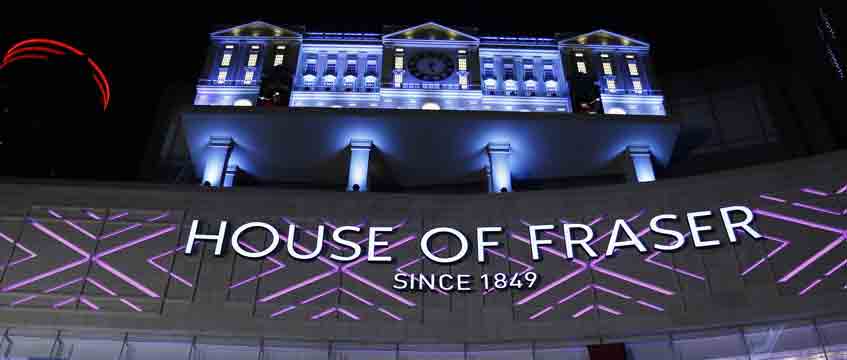Can Ashley turn House of Fraser into the ‘Harrods of the high street’?
Mike Ashley’s pre-pack acquisition of House of Fraser paints an uncertain future for the retailer and its store portfolio.
HoF had just begun a company voluntary arrangement (CVA) process that would have enabled it to close 31 of its 59 stores. But since it had not yet completed the process when Ashley’s Sports Direct group made its £90m purchase earlier this morning, it is therefore now nullified.
It puts the fate of all 59 stores – 7.7m sq ft of retail space, according to figures from Radius Data Exchange – once again under the spotlight.
Mike Ashley’s pre-pack acquisition of House of Fraser paints an uncertain future for the retailer and its store portfolio.
HoF had just begun a company voluntary arrangement (CVA) process that would have enabled it to close 31 of its 59 stores. But since it had not yet completed the process when Ashley’s Sports Direct group made its £90m purchase earlier this morning, it is therefore now nullified.
It puts the fate of all 59 stores – 7.7m sq ft of retail space, according to figures from Radius Data Exchange – once again under the spotlight.
However, Ashley has vowed: “We will do our best to keep as many stores open as possible.”
It has also emerged that the group’s premium retailer, Flannels, will play a large part in the department store’s future.
It forms part of Ashley’s ambition to “transform HoF into the Harrods of the high street”.
He said in a statement: “This is a massive step forward and further enhances our strategy of elevation across the group.
“This will benefit both HoF and Flannels in the luxury sector. It is vital that we restore the right level of ongoing relationships with the luxury brands.
“Our deal was conservative, consistent and simple,” he added.
What’s next for HoF’s stores?
The Sports Direct group, which has 494 stores – around 5.4m sq ft of retail space – consolidated its own portfolio during the year to 29 April.
It closed 32 stores but opened 13 – a net reduction of 19 – and plans to ramp up the group’s transition into large-format stores.
In recent years, the group has been rolling out a megastore concept that unites the Sports Direct, USC and Flannels businesses under the same roof.
As James Child, retail analyst at EG, points out, some of HoF’s stores could fit the bill perfectly.
It is unlikely that Ashley will want to keep all 59 stores, but the extent of a potential disposal programme remains unclear.
Independent retail analyst Richard Hyman said: “We don’t know much about what he has in mind, or what will happen to the stores; he may start off having a quiet autumn.”
However, Hyman is certain that the business will see some very drastic changes:
“He won’t trade HoF as we have known it. If he does, it will be commercially unviable. So it won’t be “rescued”, as such.”
Nick Bubb, another prominent independent retail analyst, said the £90m price tag “seems a lot to pay for HoF, even debt free, given how loss-making the business is”.
“Mike may have bitten off more than he can chew, unless he can do some side-deals,” he added.
Bubb also reckons other department store retailers could be eyeing opportunities in its real estate portfolio: “I’d be surprised [if] John Lewis and Selfridges weren’t interested in a couple of stores.”
Major changes on the horizon
Sofie Willmott, senior retail analyst at GlobalData, said that to give HoF the best chance of survival, Sports Direct must make “drastic changes” to both its store environment and product proposition to win shoppers back.
“This will require significant investment – something which the chain has been starved of in recent years,” she notes.
Willmott believes Ashley’s mixed portfolio of retail businesses could give him leverage to transform HoF into a “more upmarket department store” if he combined it with his premium retail business Agent Provocateur as well as Flannels, which sells brands like Burberry London, Fendi and Sophia Webster.
She adds: “Given the success of luxury department stores like Selfridges and Harrods, Ashley may attempt to replicate their model using HoF’s locations. However, it is questionable whether the high-end price points would appeal nationwide, particularly given that London-based department store retailers have benefited from tourism.”
A sense of relief
HoF’s landlords will no doubt be feeling some trepidation while the fate of their stores remain unclear.
But Paul Souber, co-head of retail at Colliers International, said the deal is “really a boost in confidence for both landlords and retailers as well as employees in the trade, who were due to potentially lose their jobs”.
He also pointed to the scope for Sports Direct to use its multi-channel experience to help turn around HoF’s weak store offering.
“Retailers that provide the right experience and service are really adapting the way that people shop and, as a result, are changing the requirement for the bricks and mortar store”, he said.
“It would be interesting to understand Sports Direct’s take on this and whether it really relishes the challenge, and are able to adapt HoF’s customer experience through online, physical and social sales in order to keep apace and meet the consumers requirements of today, perhaps utilising in part the Flannels fascia.”
Ashley’s vision of turning HoF into the “Harrods of the high street” sits alongside his long-held ambition to turn Sports Direct into “the Selfridges of sport”.
However, his goal of becoming the UK’s department store king will depend on his ability to modernise HoF’s stores and offer something vastly different.
To send feedback, e-mail pui-guan.man@egi.co.uk or tweet @PuiGuanM or @estatesgazette











